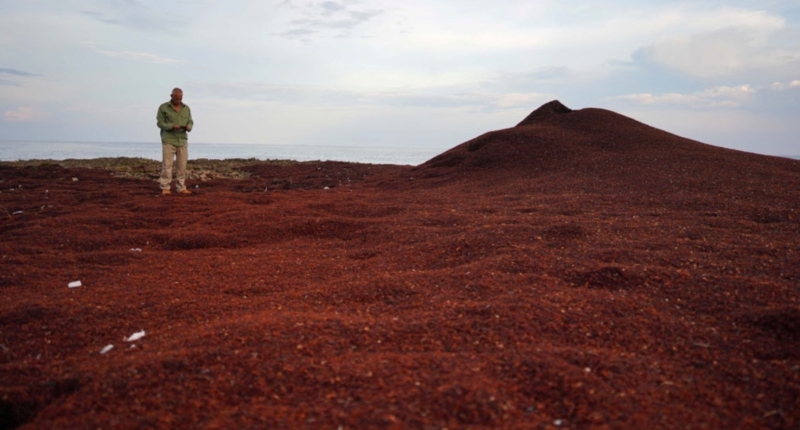Sargassum, a brown seaweed originating from the Sargasso Sea, is predicted to wash up on the shores of Southern Florida, the Caribbean, and the Yucatán Peninsula in Mexico in the coming months. Sargassum requires nutrients and sunlight to grow, and agricultural runoff seeping into the Amazon and Orinoco rivers and eventually the ocean could contribute to its increased growth. When left to decay on beaches, it can harm coastal marine ecosystems and promote the growth of fecal bacteria. Although this year’s accumulation is one of the strongest, it is not the strongest, with scientists observing larger accumulations in 2018, 2019, and 2021. While brief exposure to the seaweed is not harmful, prolonged exposure, especially for individuals with respiratory issues, can be dangerous.
A significant amount of sargassum seaweed is predicted to arrive on the shores of the Caribbean Sea, South Florida, and the Yucatán Peninsula in Mexico in the coming months. The Great Atlantic Sargassum Belt is a 5,000-mile seaweed belt that stretches from West Africa to the Gulf of Mexico and is made up of scattered patches of seaweed on the open sea, instead of a single continuous mass. Although sargassum is not new, satellite images taken in February indicated an earlier start than usual for such a large accumulation in the open ocean. Once it reaches the shore, sargassum will become a nuisance as it carpets beaches, releases a pungent odor as it decays, and ensnares humans and animals who step into it. For hotels and resorts, clearing the seaweed off beaches can be a round-the-clock operation.
Sargassum is a leafy brown seaweed adorned with berry-like structures that floats on the open ocean and reproduces on the water’s surface, unlike other seaweeds, thanks to air-filled structures that provide it with buoyancy. It originates in the Sargasso Sea, a vast stretch of the Atlantic Ocean that lies well off the southeast U.S, and is surrounded by four prevailing ocean currents rather than land boundaries. According to the National Oceanic and Atmospheric Administration, the matted brown seaweed extends for miles across the ocean and serves as a breeding ground, food source, and habitat for fish, sea turtles, and marine birds.
Sargassum presents a problem when it piles up on beaches and rapidly decomposes under the hot sun, releasing gases that emit a smell similar to rotten eggs. In recent years, sargassum has covered beaches in some Caribbean islands and the Yucatán Peninsula in Mexico during the spring and summer months, making it difficult for beach towns, cities, and hotels to keep up with the enormous amounts of seaweed that wash ashore.
It is important to note that the Great Atlantic Sargassum Belt is not one continuous mass heading straight for South Florida, but rather a dynamic and continuously changing set of pieces of this massive mass.
Sargassum, a brown seaweed that originates from the Sargasso Sea, has already reached the beaches of Key West and is predicted to arrive in larger quantities in the summer months on the shores of Southern Florida, the Caribbean, and the Yucatán Peninsula in Mexico. The amount of sargassum in the Great Atlantic Sargassum Belt is estimated to be more than 10 million metric tons, with satellite images indicating an earlier start to the algae bloom than previous years. Scientists have been closely monitoring the belt via satellite imagery since 2011, and while this year’s accumulation is one of the strongest, it is not the strongest. Scientists observed larger accumulations in 2018, 2019, and 2021.
Experts believe that sargassum requires nutrients and sunlight to grow, and the proximity to the equator provides an abundance of sunlight. Agricultural runoff entering the Amazon and Orinoco rivers and eventually the ocean could explain the increased growth of the belt on the western side, while warming waters likely help the seaweed grow faster. Changes in wind patterns, sea currents, rainfall, and drought could also affect the blooms. Dust containing iron and other nutrients from the Sahara Desert could potentially feed the entire belt in some years.
Sargassum is a nuisance when it accumulates on beaches, releasing a pungent odor as it decays and ensnaring humans and animals who step into it. Clearing the seaweed off beaches can be a challenging task for hotels, resorts, and cities as it can be a round-the-clock operation. When sargassum decomposes, it releases ammonia and hydrogen sulfide, which account for the foul smell. While brief exposure is not harmful, prolonged exposure, especially for individuals with respiratory issues, can be dangerous.
Experts are not certain whether climate change is contributing to the increase in sargassum. However, extreme weather events such as high winds, storms, and precipitation that are occurring more frequently due to climate change could be a factor.
When left to decay on beaches, sargassum can harm coastal marine ecosystems and promote the growth of fecal bacteria.
Don’t miss interesting posts on Famousbio










